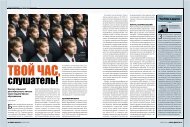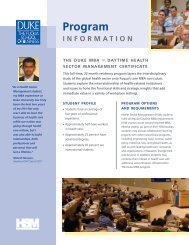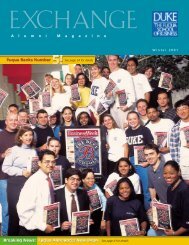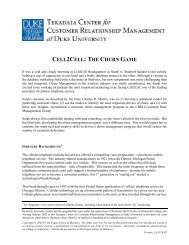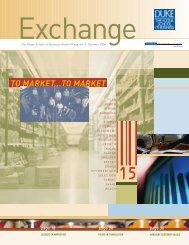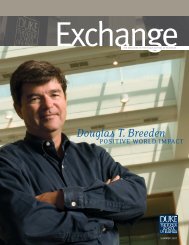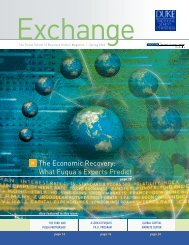Equilibrium Growth, Inflation, and Bond Yields - Duke University's ...
Equilibrium Growth, Inflation, and Bond Yields - Duke University's ...
Equilibrium Growth, Inflation, and Bond Yields - Duke University's ...
You also want an ePaper? Increase the reach of your titles
YUMPU automatically turns print PDFs into web optimized ePapers that Google loves.
sistently. Indeed, in the data innovation rates <strong>and</strong> inflation share a strong negative relationship, as predicted<br />
by the model. The top left plot of Figure 1 provides visual evidence of the negative long-run relationship<br />
between R&D <strong>and</strong> inflation. The benchmark model exhibits similar patterns which can be seen in the top<br />
right plot of Figure 1. As before, the low-frequency component is identified using a b<strong>and</strong>pass filter, where<br />
the b<strong>and</strong>width is from 32 to 200 quarters. Table 10 corroborates the visual evidence by showing that the<br />
long-run correlations between inflation <strong>and</strong> macro growth rates, including the R&D stock <strong>and</strong> measured<br />
productivity, are indeed strongly negative in the data <strong>and</strong> the benchmark model. Furthermore, the model<br />
predicts that measures related to innovation should forecast inflation rates with negative loadings on the<br />
innovation variable. This is verified in Table 8, which reports the results from projecting future inflation<br />
rates on the growth rate of the R&D stock for horizons of one to four years. In the data, the R 2 values are<br />
sizeable <strong>and</strong> the point estimates are negative <strong>and</strong> statistically significant. The forecasting regressions from<br />
the model correspond to population values. Qualitatively, the model reflects these features reasonably well.<br />
The negative long-run relationship between expected growth <strong>and</strong> inflation rates is also crucial for recon-<br />
ciling the empirical observation that increases in the term spread predict higher future economic growth. 30<br />
In the benchmark model, a positive productivity shock leads to a persistent increase in expected growth<br />
<strong>and</strong> a persistent decline in inflation. Given that the monetary authority is assumed to follow a Taylor rule<br />
<strong>and</strong> aggressively responds to inflation deviations, a persistent fall in inflation leads to sharp <strong>and</strong> persistent<br />
drop in the short-term nominal rate. Consequently, the slope of the nominal yield spread becomes steeper. 31<br />
Figure 5 verifies this intuition by showing that a positive productivity shock leads to a persistent increase<br />
in the yield spread, where the solid line corresponds to the benchmark growth model. In sum, the model<br />
predicts that a rise in the slope of the yield curve is associated with an increase in future growth rates.<br />
This is verified in table 5, which reports consumption growth forecasts with the 20 quarter yield spread. In<br />
the data, the R 2 values are sizeable <strong>and</strong> the point estimates are positive <strong>and</strong> statistically significant. The<br />
forecasting regressions from the model correspond to population values. In particular, the regressions from<br />
ENDO 1 produces R 2 that are of similar magnitude as the ones from the data <strong>and</strong> positive point estimates.<br />
To highlight the importance of the endogenous growth mechanism for explaining the term structure, it is<br />
useful to compare the benchmark model (ENDO 1) with the exogenous growth models EXO 1 (deterministic<br />
trend) <strong>and</strong> EXO 2 (stochastic trend). In EXO 1, the average nominal yield curve is upward sloping, however,<br />
the slope is counterfactually small, as reported in Table 4. This shortcoming inherently related to the<br />
inability of the model to generate a sizeable equity premium. Namely, the model lacks an strong propagation<br />
mechanism that generates quantitatively sufficient long-run consumption uncertainty. Figure 6 highlights<br />
30<br />
See, for example, Ang <strong>and</strong> Piazzesi (2006) for empirical evidence that find that term spread forecasts future<br />
growth.<br />
31<br />
Kurmann <strong>and</strong> Otrok (2011) provide empirical support for this mechanism.<br />
23





